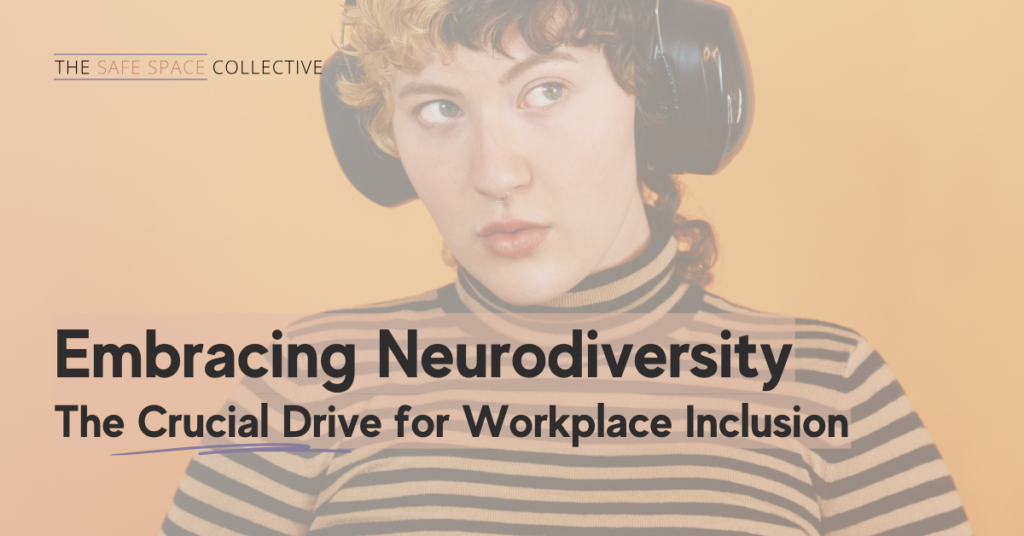Picture this: you’re tasked with embracing neurodiversity in the workplace. Sounds like a lot of effort, right? Well, it’s actually not rocket science. In fact, embracing neurodiversity is a simple matter of understanding and supporting all your employees.
The Safe Space Collective is that connection between your organisation and its neurodivergent workforce. Whether one or more of your employees identifies as neurodivergent or your team wants to take steps to ensure your workplace embraces all kinds of brains, we’re here to help. Read on for our simple roadmap to success.
What is neurodiversity? And what are autism and ADHD?
Autism and ADHD are two conditions that fall under the neurodivergent umbrella. According to April Lea, Neurodivergent Advocate, neurodiversity just means we all have different brains.
“Neurodiversity is simply the recognition that there is more than one way that the human brain can exist,” April says.
Traits of ADHD are inattentiveness, hyperactivity or a combination of both. For an Autistic person, the developmental condition can impact their interests, actions and behaviours. What’s most important to note is that everyone is unique — including their brains.
An estimated 15 to 20% of people worldwide exhibit some form of neurodivergence. So, when you think about your organisation, that means roughly one in five people in your team. As a leader, you are responsible for supporting and embracing diversity and inclusion.
When recognised and supported, your neurodivergent employees greatly benefit the workplace and your broader team. They can be innovative, creative, hard-working and display out-of-the-box thinking, so empowering them to do their best makes a lot of sense.

Embracing neurodiversity in the workplace in a few simple steps
The good news? Embracing neurodiversity in the workplace is easier than you think. And according to April, work is one of the best places to start.
“In society, we build these neuro-normative structures where only a small portion of brains have the opportunity to thrive,” April says. “Today, we have a chance to ensure everyone thrives, especially at work.”
Here are a few simple steps you can take to get started.
- Step 1: Build awareness and understanding of neurodiversity. Whether you know you’ve got an Autistic person or ADHDer on your team or you just want to embrace inclusivity, awareness is the best place to start. Begin with something simple, like a team meeting or workshop, and cover the basics of neurodiversity. Leave room for questions and comments, and make sure people feel comfortable speaking to their leaders or representatives if they want to know more.
- Step 2: Make resources available to all employees. Upload information on your intranet, have an identified support person always available, and use The Safe Space Collective for tools and resources. As your organisation’s decision-makers, you’ll find it easier to embrace neurodiversity when your team understands it.
- Step 3: Support your neurodivergent employees. Your neurodivergent employee has rights, including the right to request reasonable accommodations and adjustments that help them work better or more comfortably. So, not only is it great to act on these as soon as possible, but you should also work with them to find other ways to make their work life easier.
- Step 4: Continue to check in. Keep in touch with your whole team through regular catchups, identify gaps in awareness or training, and support your neurodivergent employees in the best way for them. Our knowledge of neurodiversity is constantly evolving and improving, so we should too.
After specific advice on how to support neurodiversity in the workplace? Let’s explore some common forms of neurodiversity.
ADHD and autism support in the workplace: how you can help
As two of the most common conditions we encounter when dealing with neurodiversity in the workplace, it can help to have specific support in place for the ADHD and Autistic people you work with. Importantly, understand that people in these neurodivergent categories are also unique, so each person requires an individual approach.
How to support ADHD in the workplace
With an estimated 3% of adults diagnosed with ADHD — and many more undiagnosed — your organisation has a responsibility to include and support neurodiversity. Here are a few impactful and actionable ways you can help.
- Make reasonable accommodations. Simple adjustments for your employees can help them work more comfortably and efficiently. The ADHDers on your team might benefit from changes like flexible start times, a permanent desk and using productivity methods like timeboxing.
- Educate your team. For some people, managing ADHD symptoms can be overwhelming, and it can affect their ability to work. To prevent discrimination, it’s vital everyone understands how a neurodivergent brain can be different and how to support ADHD in the workplace.
- Speak to The Safe Space Collective. You and your team can gain invaluable insight, plus access practical tools and resources, for supporting ADHD in the workplace. Get in touch and explore the many ways we can help.
How to accommodate autism in the workplace
Autistic people can experience symptoms or traits that make the work environment overwhelming and challenging. One in 100 Australian adults is Autistic, so if you manage a large team, understanding how to support autism in the workplace is a good idea. Check out these tips to get started.
- Include your team. Supporting autism in the workplace begins with everyone being on the same page. It can be helpful to educate your teams on autism and the nuances of behaviour that they might otherwise take the wrong way. “It’s about understanding on both sides,” April says.
- Remember the individual. It’s important not to paint every Autistic person with the same brush. Everyone will experience neurodiversity differently, including the traits and symptoms they have. Speaking one-on-one with your neurodivergent employees ensures they get the support they need. From there, you’ll have a better idea of how to accommodate autism in the workplace on an individual level.
- Help them with adjustments. Want to offer autism support in the workplace? Reasonable accommodations and adjustments, like giving explicit instructions or considering sensory sensitivities, are a good place to start. Accommodations also ensure your autistic employee is seen as an individual.
- Reach out to The Safe Space Collective. We aim to make the conversations and actions around embracing neurodiversity in the workplace easier. To ensure your leadership team understands the best approach to autism inclusion in the workplace, we’re always available to help.

Embrace neurodiversity with ongoing and evolving support
The key to embracing neurodiversity at work is to never stop. With a program of resources and valuable tools to continue the conversation and support, we’ll help you ensure your neurodivergent employees feel included and able to thrive. The Safe Space Collective’s free, seven-day trial is the best way to discover how we can help, so sign up today.



